Dr. Richard Keen, University of Colorado
Icecap Note: This is a follow-up to the posting now in Cold Storage below, on the NCAR Meehl etal study of record highs and lows that cherry-picked the starting year as 1950. The following is a graphic representation of the study from the UCAR website (below, enlarged here):

Bruce Hall did an analysis and follow-up. He extended the time period back to the start of the century and found the 1930 had a much higher frequency of maximum temperature extremes than the 1990s or 2000s or the combination of the last two decades (below, enlarged here).
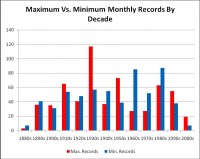
Dr. Richard Keen of the University of Colorado provided evidence from the western parts of the US and Canada supporting Bruce’s findings (below, enlarged here).
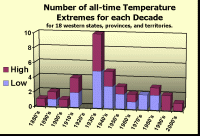
There were links also to WUWT, World Climate Report studies as well. Here below, Dr. Keen follows up his analysis expanding to all of the US and Canadian provinces and territories and shows there is no warming trend the last century.
Thanks for posting my chart of Western US and Canadian extreme temperature records by decade. I’m sure that by now the usual suspects have accused us of picking all of their cherries by showing only the western half of North America. Therefore, I spent the evening creating more charts for all 50 US states and 12 Canadian provinces and territories (excluding Nunavut, which was part of the Northwest Territories until recently).
I’m sending charts for the US, for Canada, and for the two combined. They tell the same story that my earlier Western North American graph showed, but more dramatically! MORE THAN HALF of the state and provincial maximum temperature records were set during the single decade of the 1930’s, and only 29 percent of these records were set since 1950. This means that by considering temperatures after 1950, Meehl et al. removed most of the really good heat records from the data pool, and artificially inflated the number of maximum temperature records (and thus, the max to min ratio). In other words, many of the maximum temperature records since 1950 would not be daily records for the entire period of record for these stations.
Meehl et al. calculate the max-to-min record ratio for each decade, but the difference (max MINUS min) is more illustrative (and not influenced by choice of denominator). That chart clearly shows the dominance of maximum temperature records during the 1930’s, and that since then most decades have had more minimum records set, and since 1940 minimum records have outnumbered maximum records by a ratio of 3 to 2 (or 1.5 to 1, if you prefer). Meehl et al. achieved opposite ratios by removing the extremes of the 1930’s.
No doubt the cherry pickers will note that although most of North American is included in this analysis (and not just the US), I deftly left out the Yamal Peninsula, which, as we all know, is the true key to global climate. So I’ve created one more graph - a tally of the records for the seven continents, including Asia, which includes Siberia, where the Yamal Peninsula resides. What’s it show? Since 1950, 3 maximum and 4 minimum records have been set for the continents, a fairly even break.
Finally, although I consider linear trend lines somewhat useless and occasionally deceptive, I plotted those for each graph. In all cases, the trend line is virtually indistinguishable from the zero-value axis, so it is not shown. The bottom line is that if one wishes to express climate change by the varying number of temperature extremes, there has been no climate change for over 100 years.
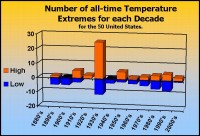
See larger here.
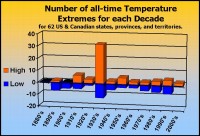
See larger here.
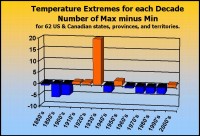
See larger here.

See larger here.


